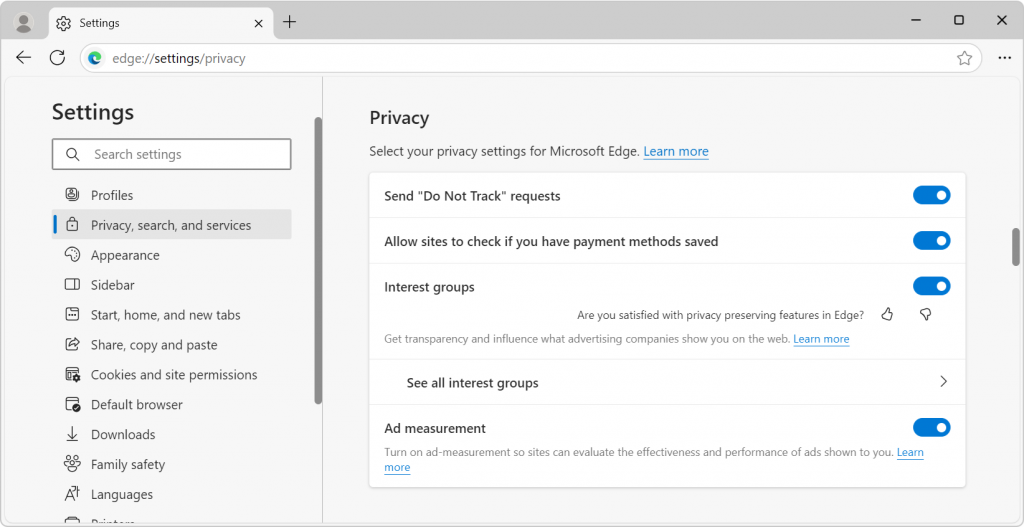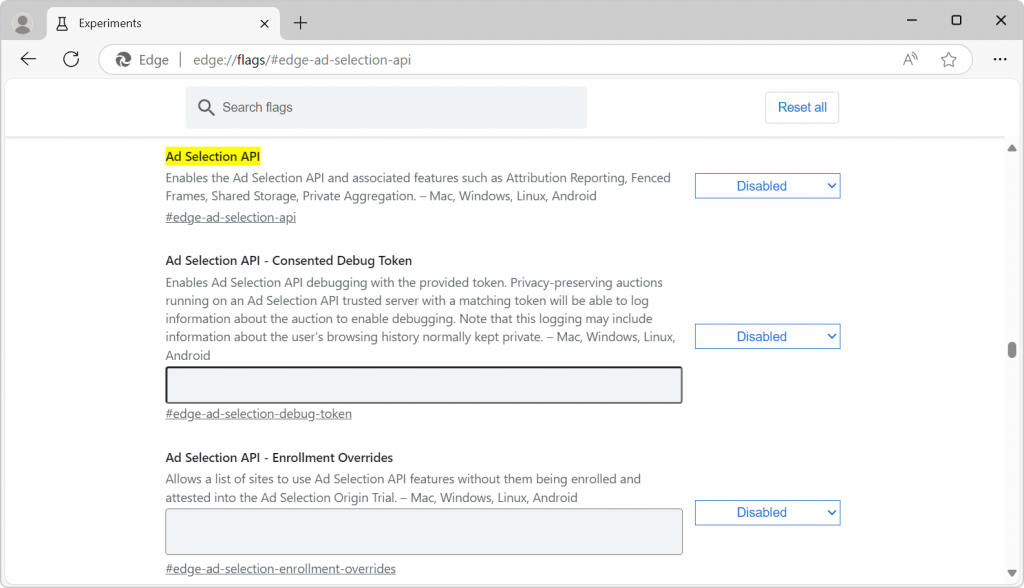Today, we’re happy to announce a limited, developer opt-in, preview of the Ad Selection API.
This preview facilitates early developer testing and feedback with the goal of enabling users to have more private browsing experiences while providing an effective solution for the web advertising ecosystem. This preview is only available in limited regions right now and excludes European Economic Area (EEA) and United Kingdom (UK).
To read the full proposal, which this preview demonstrates an initial implementation of, check out the WICG/privacy-preserving-ads GitHub repository. We encourage interested parties to engage with us directly through that repository.
We will continue to listen to feedback and collaborate in the open with the web standards community and the web advertising industry to make further improvements.
What is part of this preview?
As part of this preview experience, we are gradually rolling out various web platform features within Microsoft Edge. This includes support for a limited Origin Trial of the Ad Selection API and the associated privacy-preserving auction mechanisms. This also includes additional user settings to provide Edge users with more transparency and control, as seen below.
To learn more about the new user settings, see Privacy-preserving ads in Microsoft Edge.
When and where is the preview available?
The Ad Selection API is available in the Canary and Dev channels of Microsoft Edge versions 130.0.2808.0 and above. We will iteratively assess the API’s stability, functionality, and ecosystem feedback through a progressive rollout mechanism to determine when to expand availability as our preview progresses.
Users of Microsoft Edge who haven’t yet gotten the new functionality via the progressive rollout can opt into the feature by enabling the new testing flag. Go to edge://flags#edge-ad-selection-api in a new tab and manually enable the API.
Origin Trial
To allow developers to try out our privacy-preserving auctions end-to-end, we are also excited to announce the start of a limited Origin Trial for the Ad Selection API.
This Origin Trial includes the ability to use and deploy our container images. These images can be hosted in trusted execution environments (TEE) in a supported cloud provider such as Azure Confidential Containers via Virtual Nodes. This ensures all runtime memory is encrypted, container images are integral and untampered, and that any user data is protected and private from all parties involved.
If you are interested in trying this out, please read our developer documentation to learn more about signing up, and deploying a compatible environment.
Once you’re ready to try this out simply register for the Origin Trial and complete your developer attestation to start using the APIs. Please note that while the Origin Trial token can be placed on any website, visitors will be subject to the geographic restrictions mentioned earlier for the Origin Trial to be activated on their device.
Developer attestation
To leverage the Ad Selection API and supporting APIs, developers must provide a durable attestation that the APIs will be used for their intended purposes and will not be used to track, re-target, or otherwise try and bypass the intent of these APIs via side-channels or other mechanisms. Details of this attestation can be found in our developer documentation.
Each domain onboarded in the Origin Trial will need to host a JSON file at the https://<your domain>/.well-known/ad-selection-attestations.json location. This file must remain current and available, and contain a shared token, provided to developers by Microsoft, along with associated guarantees for the APIs that will be used.
Testing our Privacy Preserving Auctions
Any developer that has joined our Origin Trial and successfully completed attestation can start to use the APIs. We recommend performing limited traffic experiments to evaluate the performance and ergonomics of the system. To control where these APIs are used, developers can use any suitable mechanism to test including selectively using the provided Origin Trial token to enable the APIs.
Note: while you can use the provided token for all your web traffic, users visiting your site must have the right version of Edge and be in the right region for the APIs to be available and exposed.
User-facilitated testing labels
To help the web ecosystem understand how effective these APIs are in relation to current techniques, a small portion of Edge users may be within an experiment group that affects the default behavior of third-party cookies.
If you are interested in measuring the impact of this experiment, use the value returned by the Cookie-Deprecation HTTP request header or the navigator.cookieDeprecationLabel JavaScript API.
If present, the values are:
control_1.1: user has 3rd-party cookies enabled by default.treatment_1.1: user has 3rd-party cookies disabled by default.
Providing feedback
This is meant as an early opportunity for feedback from all interested parties. Feedback from both Edge users and web developers are important to ensuring the best possible solution.
If you experience any issues, or if you have any feedback or requests while trying out the Ad Selection API, please let us know by using the feedback window in Microsoft Edge: go to Settings and more (…) > Help and feedback > Send feedback.
You can also open a new issue on our GitHub repository or join on one of our biweekly calls to discuss.




